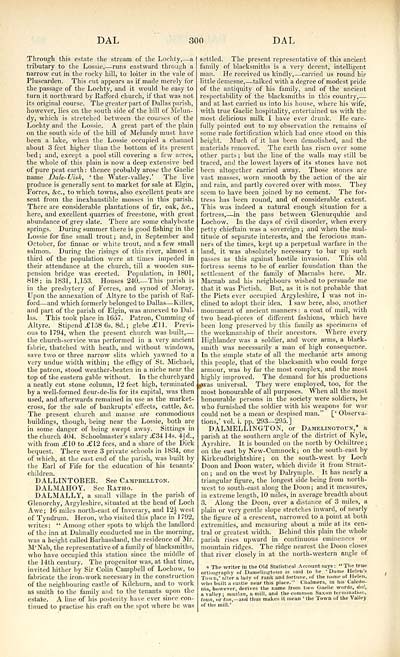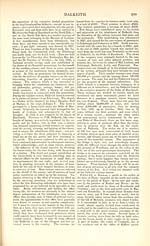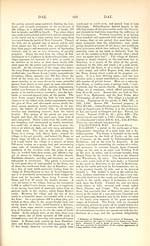Topographical, statistical, and historical gazetteer of Scotland > Volume 1
(382) Page 300
Download files
Complete book:
Individual page:
Thumbnail gallery: Grid view | List view

DAL
300
DAL
Through this estate the stream of the Lochty, — a
tributary to the Lossie, — runs eastward through a
narrow cut in the rocky hill, to loiter in the vale of
Pluscarden. This cut appears as if made merely for
the passage of the Lochty, and it would be easy to
turn it northward by Rafford church, if that was not
its original course. The greater part of Dallas parish,
however, lies on the south side of the hill of Melun-
dy, which is stretched between the courses of the
Lochty and the Lossie. A great part of the plain
on the south side of the hill of Melundy must have
been a lake, when the Lossie occupied a channel
about 3 feet higher than the bottom of its present
bed ; and, except a pool still covering a few acres,
the whole of this plain is now a deep extensive bed
of pure peat earth : thence probably arose the Gaelic
name Dale-Visk, 'the Water- valley.' The live
produce is generally sent to market for sale at Elgin,
Forres, &c, to which towns, also excellent peats are
sent from the inexhaustible mosses in this parish.
There are considerable plantations of fir, oak, &c,
here, and excellent quarries of freestone, with great
abundance of grey slate. There are some chalybeate
springs. During summer there is good fishing in the
Lossie for fine small trout ; and, in September and
October, for finnac or white trout, and a few small
salmon. During the risings of this river, almost a
third of the population were at times impeded in
their attendance at the church, till a wooden sus-
pension bridge was erected. Population, in 1801,
818; in 1831, 1,153. Houses 240 This parish is
in the presbytery of Forres, and synod of Moray.
Upon the annexation of Altyre to the parish of Raf-
ford — and which formerly belonged to Dallas — Killes,
and part of the parish of Elgin, was annexed to Dal-
las. This took place in 1657. Patron, Cumming of
Altyre. Stipend £158 6s. 8d. ; glebe £11. Previ-
ous to 1794, when the present church was built, —
the church-service was performed in a very ancient
fabric, thatched with heath, and without windows,
save two or three narrow slits which yawned to a
very undue width within; the effigy of St. Michael,
the patron, stood weather-beaten in a niche near the
top of the eastern gable without. In the churchyard
a neatly cut stone column, 12 feet high, terminated
by a well-formed fleur-de-lis for its capital, was then
used, and afterwards remained in use as the. market-
cross, for the sale of bankrupts' effects, cattle, &c.
The present church and manse are commodious
buildings, though, being near the Lossie, both are
in some danger of being swept away. Sittings in
the church 404. Schoolmaster's salary £34 14s. 4^d.,
with from £10 to £12 fees, and a share of the Dick
bequest. There were 3 private schools in 1834, one
of which, at the east end of the parish, was built by
the Earl of Fife for the education of his tenants'
children.
DALLINTOBER. See Campbeixton.
DALMAHOY. See Ratho.
DALMALLY, a small village in the parish of
Glenorchy, Argyleshire, situated at the head of Loch
Awe; 16 miles north-east of Inverary, and 12| west
of Tyndrum. Heron, who visited this place in 1792,
writes: " Among other spots to which the landlord
of the inn at Dalmally conducted me in the morning,
was a height called Barhassland, the residence of Mr.
M'Nab, the representative of a family of blacksmiths,
who have occupied this station since the middle of
the 14th century. The progenitor was, at that time,
invited hither by Sir Colin Campbell of Lochow, to
fabricate the iron-work necessary in the construction
of the neighbouring castle of Kilchurn, and to work
as smith to the family and to the tenants upon the
estate. A line of his posterity have ever since con-
tinued to practise his craft on the spot where he was
settled. The present representative of this ancient
family of blacksmiths is a very decent, intelligent
man. He received us kindly, — carried us round hi?
little demesne, — talked with a degree of modest pride
of the antiquity of his family, and of the ancient
respectability of the blacksmiths in this country, —
and at last carried us into his house, where his wife,
with true Gaelic hospitality, entertained us with the
most delicious milk I have ever drunk. He care-
fully pointed out to my observation the remains of
some rude fortification which had once stood on this
height. Much of it has been demolished, and the
materials removed. The earth has risen over some
other parts ; but the fine of the walls may still be
traced, and the lowest layers of its stones have not
been altogether carried away. Those stones are
vast masses, worn smooth by the action of the air
and rain, and partly covered over with moss. They
seem to have been joined by no cement. The for-
tress has been round, and of considerable extent.
This was indeed a natural enough situation for a
fortress, — in the pass between Glenurquhie and
Lochow. In the days of civil disorder, when every
petty chieftain was a sovereign ; and when the mul-
titude of separate interests, and the ferocious man-
ners of the times, kept up a perpetual warfare in the
land, it was absolutely necessary to bar up such
passes as this against hostile invasion. This old
fortress seems to be of earlier foundation than the
settlement of the family of Macnabs here. Mr.
Macnab and his neighbours wished to persuade me
that it was Pictish. But, as it is not probable that
the Picts ever occupied Argyleshire, I was not in-
clined to adopt their idea. I saw here, also, another
monument of ancient manners : a coat of mail, with
two head-pieces of different fashions, which have
been long preserved by this family as specimens of
the workmanship of their ancestors. Where every
Highlander was a soldier, and wore arms, a black-
smith was necessarily a man of high consequence.
In the simple state of all the mechanic arts among
this people, that of the blacksmith who could forge
armour, was by far the most complex, and the most
highly improved. The demand for his productions
jjwas universal. They were employed, too, for the
most honourable of all purposes. When all the most
honourable persons in the society were soldiers, he
who furnished the soldier with his weapons for war
could not be a mean or despised man." [' Observa-
tions,' vol. i. pp. 293—295.]
DALMELLINGTON, or Damelingtoun,* a
parish at the southern angle of the district of Kyle,
Ayrshire. It is bounded on the north by Ochiltree ;
on the east by New-Cumnock; on the south-east by
Kirkcudbrightshire; on the south-west by Loch
Doon and Doon water, which divide it from Strait-
on ; and on the west by Dalrymple. It has nearly a
triangular figure, the longest side being from north-
west to south-east along the Doon ; and it measures,
in extreme length, 10 miles, in average breadth about
3. Along the Doon, over a distance of 3 miles, a
plain or very gentle slope stretches inward, of nearly
the figure of a crescent, narrowed to a point at both
extremities, and measuring about a mile at its cen-
tral or greatest width. Behind this plain the whole
parish rises upward in continuous eminences or
mountain ridges. The ridge nearest the Doon closes
that river closely in at the north-western angle of
* The writer in the Old Statistical Account says : " The true
orthography of Damelingtoun is said to be 'Dame Helen's
Town,' after a ladv of rank and fortune, of the name of Helen,
who built a castle 'near this place." Chalmers, m his Caledo-
nia, however, derives the name from two Gaelic words, dut,
a valley: mutton, a mill,, and the common Saxon termination,
toun, or tot,— and thus makes it mean ' the Town of the Valley
of the mill.'
300
DAL
Through this estate the stream of the Lochty, — a
tributary to the Lossie, — runs eastward through a
narrow cut in the rocky hill, to loiter in the vale of
Pluscarden. This cut appears as if made merely for
the passage of the Lochty, and it would be easy to
turn it northward by Rafford church, if that was not
its original course. The greater part of Dallas parish,
however, lies on the south side of the hill of Melun-
dy, which is stretched between the courses of the
Lochty and the Lossie. A great part of the plain
on the south side of the hill of Melundy must have
been a lake, when the Lossie occupied a channel
about 3 feet higher than the bottom of its present
bed ; and, except a pool still covering a few acres,
the whole of this plain is now a deep extensive bed
of pure peat earth : thence probably arose the Gaelic
name Dale-Visk, 'the Water- valley.' The live
produce is generally sent to market for sale at Elgin,
Forres, &c, to which towns, also excellent peats are
sent from the inexhaustible mosses in this parish.
There are considerable plantations of fir, oak, &c,
here, and excellent quarries of freestone, with great
abundance of grey slate. There are some chalybeate
springs. During summer there is good fishing in the
Lossie for fine small trout ; and, in September and
October, for finnac or white trout, and a few small
salmon. During the risings of this river, almost a
third of the population were at times impeded in
their attendance at the church, till a wooden sus-
pension bridge was erected. Population, in 1801,
818; in 1831, 1,153. Houses 240 This parish is
in the presbytery of Forres, and synod of Moray.
Upon the annexation of Altyre to the parish of Raf-
ford — and which formerly belonged to Dallas — Killes,
and part of the parish of Elgin, was annexed to Dal-
las. This took place in 1657. Patron, Cumming of
Altyre. Stipend £158 6s. 8d. ; glebe £11. Previ-
ous to 1794, when the present church was built, —
the church-service was performed in a very ancient
fabric, thatched with heath, and without windows,
save two or three narrow slits which yawned to a
very undue width within; the effigy of St. Michael,
the patron, stood weather-beaten in a niche near the
top of the eastern gable without. In the churchyard
a neatly cut stone column, 12 feet high, terminated
by a well-formed fleur-de-lis for its capital, was then
used, and afterwards remained in use as the. market-
cross, for the sale of bankrupts' effects, cattle, &c.
The present church and manse are commodious
buildings, though, being near the Lossie, both are
in some danger of being swept away. Sittings in
the church 404. Schoolmaster's salary £34 14s. 4^d.,
with from £10 to £12 fees, and a share of the Dick
bequest. There were 3 private schools in 1834, one
of which, at the east end of the parish, was built by
the Earl of Fife for the education of his tenants'
children.
DALLINTOBER. See Campbeixton.
DALMAHOY. See Ratho.
DALMALLY, a small village in the parish of
Glenorchy, Argyleshire, situated at the head of Loch
Awe; 16 miles north-east of Inverary, and 12| west
of Tyndrum. Heron, who visited this place in 1792,
writes: " Among other spots to which the landlord
of the inn at Dalmally conducted me in the morning,
was a height called Barhassland, the residence of Mr.
M'Nab, the representative of a family of blacksmiths,
who have occupied this station since the middle of
the 14th century. The progenitor was, at that time,
invited hither by Sir Colin Campbell of Lochow, to
fabricate the iron-work necessary in the construction
of the neighbouring castle of Kilchurn, and to work
as smith to the family and to the tenants upon the
estate. A line of his posterity have ever since con-
tinued to practise his craft on the spot where he was
settled. The present representative of this ancient
family of blacksmiths is a very decent, intelligent
man. He received us kindly, — carried us round hi?
little demesne, — talked with a degree of modest pride
of the antiquity of his family, and of the ancient
respectability of the blacksmiths in this country, —
and at last carried us into his house, where his wife,
with true Gaelic hospitality, entertained us with the
most delicious milk I have ever drunk. He care-
fully pointed out to my observation the remains of
some rude fortification which had once stood on this
height. Much of it has been demolished, and the
materials removed. The earth has risen over some
other parts ; but the fine of the walls may still be
traced, and the lowest layers of its stones have not
been altogether carried away. Those stones are
vast masses, worn smooth by the action of the air
and rain, and partly covered over with moss. They
seem to have been joined by no cement. The for-
tress has been round, and of considerable extent.
This was indeed a natural enough situation for a
fortress, — in the pass between Glenurquhie and
Lochow. In the days of civil disorder, when every
petty chieftain was a sovereign ; and when the mul-
titude of separate interests, and the ferocious man-
ners of the times, kept up a perpetual warfare in the
land, it was absolutely necessary to bar up such
passes as this against hostile invasion. This old
fortress seems to be of earlier foundation than the
settlement of the family of Macnabs here. Mr.
Macnab and his neighbours wished to persuade me
that it was Pictish. But, as it is not probable that
the Picts ever occupied Argyleshire, I was not in-
clined to adopt their idea. I saw here, also, another
monument of ancient manners : a coat of mail, with
two head-pieces of different fashions, which have
been long preserved by this family as specimens of
the workmanship of their ancestors. Where every
Highlander was a soldier, and wore arms, a black-
smith was necessarily a man of high consequence.
In the simple state of all the mechanic arts among
this people, that of the blacksmith who could forge
armour, was by far the most complex, and the most
highly improved. The demand for his productions
jjwas universal. They were employed, too, for the
most honourable of all purposes. When all the most
honourable persons in the society were soldiers, he
who furnished the soldier with his weapons for war
could not be a mean or despised man." [' Observa-
tions,' vol. i. pp. 293—295.]
DALMELLINGTON, or Damelingtoun,* a
parish at the southern angle of the district of Kyle,
Ayrshire. It is bounded on the north by Ochiltree ;
on the east by New-Cumnock; on the south-east by
Kirkcudbrightshire; on the south-west by Loch
Doon and Doon water, which divide it from Strait-
on ; and on the west by Dalrymple. It has nearly a
triangular figure, the longest side being from north-
west to south-east along the Doon ; and it measures,
in extreme length, 10 miles, in average breadth about
3. Along the Doon, over a distance of 3 miles, a
plain or very gentle slope stretches inward, of nearly
the figure of a crescent, narrowed to a point at both
extremities, and measuring about a mile at its cen-
tral or greatest width. Behind this plain the whole
parish rises upward in continuous eminences or
mountain ridges. The ridge nearest the Doon closes
that river closely in at the north-western angle of
* The writer in the Old Statistical Account says : " The true
orthography of Damelingtoun is said to be 'Dame Helen's
Town,' after a ladv of rank and fortune, of the name of Helen,
who built a castle 'near this place." Chalmers, m his Caledo-
nia, however, derives the name from two Gaelic words, dut,
a valley: mutton, a mill,, and the common Saxon termination,
toun, or tot,— and thus makes it mean ' the Town of the Valley
of the mill.'
Set display mode to: Large image | Transcription
Images and transcriptions on this page, including medium image downloads, may be used under the Creative Commons Attribution 4.0 International Licence unless otherwise stated. ![]()
| Gazetteers of Scotland, 1803-1901 > Topographical, statistical, and historical gazetteer of Scotland > Volume 1 > (382) Page 300 |
|---|
| Permanent URL | https://digital.nls.uk/97442130 |
|---|
| Description | Volume first. A-H. |
|---|---|
| Attribution and copyright: |
|

